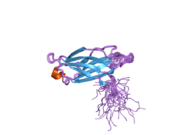| SYT7 |
|---|
 |
| Available structures |
|---|
| PDB | Ortholog search: PDBe RCSB |
|---|
|
|
| Identifiers |
|---|
| Aliases | SYT7, IPCA-7, IPCA7, PCANAP7, SYT-VII, SYTVII, synaptotagmin 7 |
|---|
| External IDs | OMIM: 604146 MGI: 1859545 HomoloGene: 20889 GeneCards: SYT7 |
|---|
| Gene location (Human) |
|---|
 | | Chr. | Chromosome 11 (human)[1] |
|---|
| | Band | 11q12.2 | Start | 61,513,714 bp[1] |
|---|
| End | 61,581,148 bp[1] |
|---|
|
| Gene location (Mouse) |
|---|
 | | Chr. | Chromosome 19 (mouse)[2] |
|---|
| | Band | 19|19 A | Start | 10,366,454 bp[2] |
|---|
| End | 10,430,544 bp[2] |
|---|
|
| RNA expression pattern |
|---|
| Bgee | | Human | Mouse (ortholog) |
|---|
| Top expressed in | - islet of Langerhans
- Brodmann area 9
- prefrontal cortex
- cerebellar vermis
- cingulate gyrus
- right lobe of liver
- pituitary gland
- parotid gland
- anterior pituitary
- superior frontal gyrus
|
| | Top expressed in | - medial dorsal nucleus
- medial geniculate nucleus
- dentate gyrus
- piriform cortex
- substantia nigra
- cerebellar cortex
- cerebellar vermis
- superior frontal gyrus
- pontine nuclei
- olfactory tubercle
|
| | More reference expression data |
|
|---|
| BioGPS | |
|---|
|
| Gene ontology |
|---|
| Molecular function | - calcium ion binding
- metal ion binding
- protein binding
- SNARE binding
- syntaxin binding
- clathrin binding
- phosphatidylinositol-4,5-bisphosphate binding
- calcium-dependent phospholipid binding
- calmodulin binding
- phosphatidylserine binding
| | Cellular component | - integral component of membrane
- membrane
- synapse
- synaptic vesicle membrane
- cell junction
- terminal bouton
- dense core granule
- extracellular exosome
- cytoplasmic vesicle
- transport vesicle membrane
- cytosol
- synaptic vesicle
- presynaptic membrane
- lysosome
- peroxisome
- peroxisomal membrane
- phagocytic vesicle membrane
- plasma membrane
- lysosomal membrane
- early phagosome
- dendrite
- neuronal cell body
- axon terminus
- axon
- neuron projection
- exocytic vesicle
- hippocampal mossy fiber to CA3 synapse
- glutamatergic synapse
- GABA-ergic synapse
- integral component of presynaptic membrane
| | Biological process | - regulation of insulin secretion
- positive regulation of calcium ion-dependent exocytosis
- exocytosis
- regulation of bone remodeling
- plasma membrane repair
- calcium-ion regulated exocytosis
- regulation of calcium ion-dependent exocytosis
- calcium ion-regulated exocytosis of neurotransmitter
- regulation of glucagon secretion
- phagosome-lysosome fusion
- synaptic vesicle recycling
- vesicle-mediated cholesterol transport
- regulation of phagocytosis
- vesicle fusion
- calcium ion regulated lysosome exocytosis
- phagocytosis
- regulation of dopamine secretion
- short-term synaptic potentiation
- vesicle-mediated transport
- cellular response to calcium ion
- calcium-dependent activation of synaptic vesicle fusion
- regulation of synaptic vesicle endocytosis
| | Sources:Amigo / QuickGO |
|
| Orthologs |
|---|
| Species | Human | Mouse |
|---|
| Entrez | | |
|---|
| Ensembl | | |
|---|
| UniProt | | |
|---|
| RefSeq (mRNA) | NM_001252065
NM_001300773
NM_004200
NM_001365809
NM_001370210
|
|---|
NM_001370211 |
| |
|---|
NM_018801
NM_173067
NM_173068
NM_001373944 |
|
|---|
| RefSeq (protein) | NP_001238994
NP_001287702
NP_004191
NP_001352738
NP_001357139
|
|---|
NP_001357140 |
| |
|---|
NP_061271
NP_775090
NP_775091 |
|
|---|
| Location (UCSC) | Chr 11: 61.51 – 61.58 Mb | Chr 19: 10.37 – 10.43 Mb |
|---|
| PubMed search | [3] | [4] |
|---|
|
| Wikidata |
| View/Edit Human | View/Edit Mouse |
|

 2d8k: Solution structure of the first C2 domain of synaptotagmin VII
2d8k: Solution structure of the first C2 domain of synaptotagmin VII

















